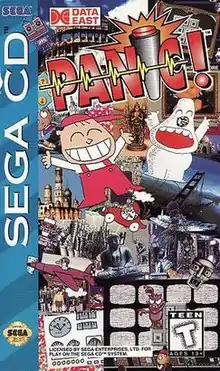Panic! (video game)
Panic! (known as SWITCH (スイッチ, Suitchi) in Japan) is a puzzle point and click video game developed by Sega and Office I and published by Sega in Japan and Data East USA in North America for the Sega CD, in collaboration with the Theatrical Group WAHAHA Hompo. It was released on April 23, 1993 in Japan, localized to North America in 1994, and later released for the PlayStation 2 in Japan on August 8, 2002. The game involves pressing numerous buttons in order to transverse a young boy, called Slap, or his dog, called Stick, through a complex labyrinth. It is one of the few Sega CD games that supports the Sega Mega Mouse.[1]
| Panic! | |
|---|---|
 North American cover art | |
| Developer(s) | Sega Office I Wahaha Honpo |
| Publisher(s) | |
| Producer(s) | Hajime Tabe |
| Artist(s) | Renzo Kinoshita |
| Composer(s) | Kei Tani |
| Platform(s) | Sega CD, PlayStation 2 |
| Release | Sega CD PlayStation 2
|
| Genre(s) | Puzzle Point and click |
| Mode(s) | Single player |
Story
During the intro, the game explains that a virus has infected the world's computer systems. Slap and his dog Stick (who has been sucked into his TV) must carry an antidote to the central computer to fix it. To this end, Slap and Stick must traverse a grid of levels, pushing buttons to advance.
Gameplay
Each level is presented as a new area with a mechanical device, and a set of buttons to press. Each button causes an animation and/or teleports Slap to another room. Sometimes the buttons are booby-trapped and cause the destruction of a variety of monuments. The grid also features a few game overs on the grid, marked by flashing skulls on the map. The buttons themselves have no indication on what they do when pressed. It is possible to backtrack into previous levels, and buttons once pressed are not marked, unless they were booby-trapped.
Version differences
Two stages were removed for the North American release: Level 2-B, a scene with a cigarette machine, and Level 9-B, featuring a Japanese typewriter. The level 12-D sends the player to the Japanese Mega-CD BIOS screen, but this scene was not changed in the North American version and still showed the Japanese BIOS screen instead of the American one.
Reception
The four reviewers of Electronic Gaming Monthly noted that Panic! is not actually a game, but opined that it is nonetheless very original and enjoyable for a while, though all but one of them also felt it gets boring fairly quickly. They particularly enjoyed the high quality animations and often "sick" sense of humor, and gave it a score of 5.75 out of 10.[1] GamePro panned the game, chiefly for its trial-and-error gameplay which requires players to watch many "pointless" scenes. They added, "You might feel differently if there were at least great jokes coming from the switches, but the humor is mostly simplistic cartoons with childish graphics, like basic versions of animations from Monty Python." They gave Panic! a 2.0 out of 5 for graphics, 4.0 for sound, and 1.0 for both control and funfactor,[2] making it one of only 12 games in GamePro history to earn a score of 1.0 or lower.[3] Game Players magazine described the game as being made "for people on drugs, by people on drugs."
Richard Leadbetter, editor of Mean Machines Sega, awarded the Japanese version of the game a score of 90%.[4]
Next Generation reviewed the Sega CD version of the game, rating it two stars out of five, and stated that "Panic wants to defy description and critical analysis. [...] In a word, weird."[5]
References
- "Review Crew: Panic". Electronic Gaming Monthly. No. 63. Sendai Publishing. October 1994. p. 34.
- "ProReview: Panic!". GamePro. No. 82. IDG. July 1995. p. 49.
- "The Worst of the Worst". GamePro. No. 200. May 2005. p. 53.
- Leadbetter, Richard; Rignall, Julian (1993). Mean Machines: The Essential Sega Guide. London: Virgin Books. p. 126. ISBN 0-86369-708-9.
- "Finals". Next Generation. No. 2. Imagine Media. February 1995. p. 99.
External links
- Official page of PS2 version
- Panic! at Hardcore Gaming 101
- Panic featured onClassicGaming
- Panic on Everything2
- Panic! at MobyGames